Do you have a question about the Novation ZeRO SL MkII and is the answer not in the manual?
Details controls that can be assigned to software or hardware parameters.
Describes controls with fixed functions and their operation.
Illustrates and explains all rear panel input and output ports.
Explains the self-calibration process upon powering up the device.
Connects the device to a computer for controlling music software via USB.
Connects the device to external MIDI hardware using MIDI cables and PSU.
Combines software and hardware control, acting as a MIDI interface.
Instructions on how to activate Automap Mode by pressing the Automap button.
Details the function of system buttons within Automap Mode for navigation and control.
Explains the unique template used in Automap Mode and assignable controls.
Describes the dual functions of the Speed Dial knob in Automap Mode.
Explains the three sub-connections (ports) within the USB connection.
Provides setup examples for controlling various DAWs and software with Automap.
Discusses using Automap MIDI for hardware control and special templates.
Instructions on how to switch between the 32 pre-built templates.
Defines a template and lists controls unavailable in Advanced Mode.
Explains the Speed Dial knob's functions in Template mode.
Details routing MIDI data to output ports in Advanced Mode.
Explains using Advanced mode templates for complex systems with MIDI and USB ports.
Describes special templates offering feedback and enhanced control for specific DAWs.
Explains how to enter, exit, and navigate through menus using controls.
Details the process for saving changes to templates and global settings.
Describes how to select options and scroll through pages within menus.
Outlines the three levels of settings: control, template, and global.
Lists commonly used functions accessible via the Quick Menu.
Provides access to Template Edit and Control Edit modes.
Allows editing settings that affect the entire loaded template.
Configures rotary pots and sliders' response when switching templates.
Defines MIDI channel and port routing for Drum Pads, Pedals, and other controls.
Explains how to group and manage multiple templates together.
Guides on entering Control Edit Mode to modify individual control settings.
Presents options for Memory Protect, Display Timeout, Keep Values, and Touch Select.
Configures startup mode, template selection, and automatic demonstration.
Sets MIDI data routing for USB and MIDI ports, including clock and tempo.
Configures MIDI channels and ports for receiving program change messages.
Manages template and global settings dumps, and OS updates via MIDI/USB.
Guides on calibrating drum pads for velocity sensitivity.
Explains how to save all global settings.
Details how to use and configure transport control buttons.
Shows which MIDI messages can be assigned to physical controls.
Details settings for Control Change messages, including display type.
Explains specific encoder settings like REL1, REL2, 0-16K, and APOT.
Allows setting the upper and lower limits for control values.
Covers display types, LED behavior, and button types (Normal, Momentary, Toggle, Step).
Configures port routing and common/program port settings for controls.
Sets the MIDI channel for transmitting data (1-16, ProgCHAN, ComnCHAN).
Sets the Control Change number for a control (0-127).
Configures control response when switching templates (ON, OFF, GLOBAL, TEMPLATE).
Details settings for NRPN Least and Most Significant Bytes.
Details settings for RPN Least and Most Significant Bytes.
Explains settings for SYSEX messages, including Length, DataType, and DataPsn.
Covers MMC message settings for transport control (Command, DeviceID).
Configures Note On/Off messages, including Note value, Velocity, and Button Type.
Explains settings for Bank Change messages (BankMode, LSB, MSB, MSB-LSB).
Details settings for Program Change messages, including Low/High Program numbers.
Configures Drum Pad Note messages, including Auto-Off and Off Sync.
Covers standard MIDI system real-time messages like Start, Continue, Stop.
Allows setting controls to switch to different templates on the device.
Details controls that can be assigned to software or hardware parameters.
Describes controls with fixed functions and their operation.
Illustrates and explains all rear panel input and output ports.
Explains the self-calibration process upon powering up the device.
Connects the device to a computer for controlling music software via USB.
Connects the device to external MIDI hardware using MIDI cables and PSU.
Combines software and hardware control, acting as a MIDI interface.
Instructions on how to activate Automap Mode by pressing the Automap button.
Details the function of system buttons within Automap Mode for navigation and control.
Explains the unique template used in Automap Mode and assignable controls.
Describes the dual functions of the Speed Dial knob in Automap Mode.
Explains the three sub-connections (ports) within the USB connection.
Provides setup examples for controlling various DAWs and software with Automap.
Discusses using Automap MIDI for hardware control and special templates.
Instructions on how to switch between the 32 pre-built templates.
Defines a template and lists controls unavailable in Advanced Mode.
Explains the Speed Dial knob's functions in Template mode.
Details routing MIDI data to output ports in Advanced Mode.
Explains using Advanced mode templates for complex systems with MIDI and USB ports.
Describes special templates offering feedback and enhanced control for specific DAWs.
Explains how to enter, exit, and navigate through menus using controls.
Details the process for saving changes to templates and global settings.
Describes how to select options and scroll through pages within menus.
Outlines the three levels of settings: control, template, and global.
Lists commonly used functions accessible via the Quick Menu.
Provides access to Template Edit and Control Edit modes.
Allows editing settings that affect the entire loaded template.
Configures rotary pots and sliders' response when switching templates.
Defines MIDI channel and port routing for Drum Pads, Pedals, and other controls.
Explains how to group and manage multiple templates together.
Guides on entering Control Edit Mode to modify individual control settings.
Presents options for Memory Protect, Display Timeout, Keep Values, and Touch Select.
Configures startup mode, template selection, and automatic demonstration.
Sets MIDI data routing for USB and MIDI ports, including clock and tempo.
Configures MIDI channels and ports for receiving program change messages.
Manages template and global settings dumps, and OS updates via MIDI/USB.
Guides on calibrating drum pads for velocity sensitivity.
Explains how to save all global settings.
Details how to use and configure transport control buttons.
Shows which MIDI messages can be assigned to physical controls.
Details settings for Control Change messages, including display type.
Explains specific encoder settings like REL1, REL2, 0-16K, and APOT.
Allows setting the upper and lower limits for control values.
Covers display types, LED behavior, and button types (Normal, Momentary, Toggle, Step).
Configures port routing and common/program port settings for controls.
Sets the MIDI channel for transmitting data (1-16, ProgCHAN, ComnCHAN).
Sets the Control Change number for a control (0-127).
Configures control response when switching templates (ON, OFF, GLOBAL, TEMPLATE).
Details settings for NRPN Least and Most Significant Bytes.
Details settings for RPN Least and Most Significant Bytes.
Explains settings for SYSEX messages, including Length, DataType, and DataPsn.
Covers MMC message settings for transport control (Command, DeviceID).
Configures Note On/Off messages, including Note value, Velocity, and Button Type.
Explains settings for Bank Change messages (BankMode, LSB, MSB, MSB-LSB).
Details settings for Program Change messages, including Low/High Program numbers.
Configures Drum Pad Note messages, including Auto-Off and Off Sync.
Covers standard MIDI system real-time messages like Start, Continue, Stop.
Allows setting controls to switch to different templates on the device.
| Mixer section | Yes |
|---|---|
| Product color | Silver |
| Scratcher type | - |
| Display type | LCD |
| USB connector type | USB Type-B |
| Power supply type | USB |
| Mac operating systems supported | Mac OS X 10.10 Yosemite, Mac OS X 10.8 Mountain Lion, Mac OS X 10.9 Mavericks |
| Windows operating systems supported | Windows 7 Enterprise, Windows 7 Enterprise x64, Windows 7 Home Basic, Windows 7 Home Basic x64, Windows 7 Home Premium, Windows 7 Home Premium x64, Windows 7 Professional, Windows 7 Professional x64, Windows 7 Starter, Windows 7 Starter x64, Windows 7 Ultimate, Windows 7 Ultimate x64, Windows 8 Enterprise, Windows 8 Enterprise x64, Windows 8 Pro, Windows 8 x64 |
| Depth | 200 mm |
|---|---|
| Width | 445 mm |
| Height | 68 mm |
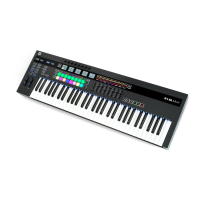
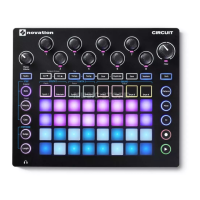
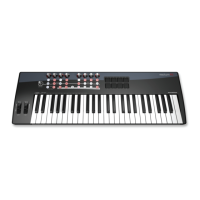
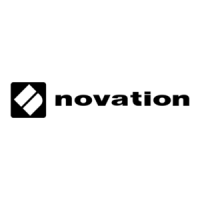
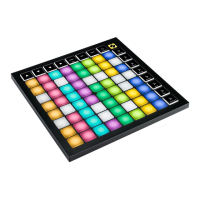
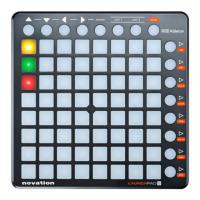
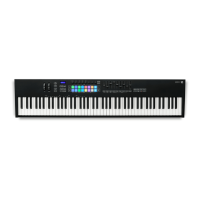
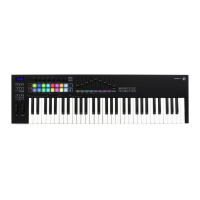
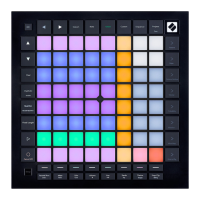
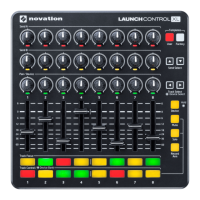

![Preview: Novation Launchpad Mini [MK3]](https://data.easymanua.ls/products/284351/200x200/novation-launchpad-mini-mk3.webp)